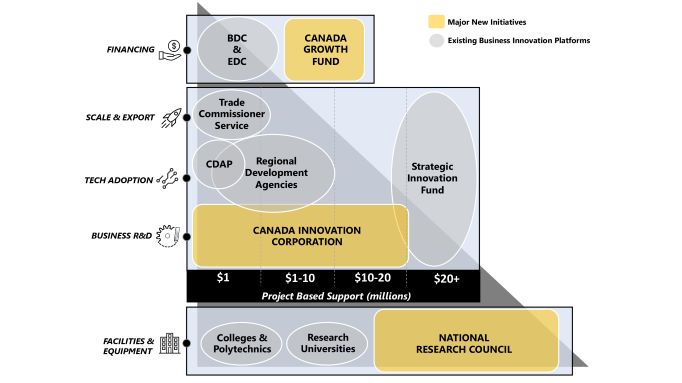Questions and answers about Canada’s new innovation agency
NOTE: See also main story, “New innovation agency’s success hinges on its private sector leadership, experts say”
Research Money was invited by federal government officials to a technical briefing prior to the announcement of the new Canada Innovation Corporation (CIC). This FAQ is based on information provided in that briefing, as well as the government’s news release and blueprint for the CIC and interviews by Research Money.

Why does Canada need a new innovation agency?
Canadian businesses do not invest in R&D at the same level as their international counterparts, resulting in economic productivity that lags many other countries, Ottawa says.
The CIC will address this challenge by having a “focused, outcome-driven mandate to increase Canadian business expenditure on R&D across all sectors and regions of Canada, and help to generate new and improved products and processes that will support the productivity and growth of Canadian firms,” according to the CIC’s blueprint.
The CIC is based on best practices of successful international innovation agencies, including the Israel Innovation Authority and Business Finland.
What is the Canada Innovation Corporation’s purpose and what are its goals?
The CIC will be market-driven and deliver support in a more accessible way across the Canadian economy to drive innovation-based growth, Ottawa says.
The corporation will not only focus on high-technology firms, but will design programs and services to target businesses operating in established commodity-based and manufacturing industries to help them turn inventions into innovations and build on Canada’s natural comparative advantages.
In addition, the CIC will:
- build a pipeline of high-potential Canadian firms that can then go on to access growth financing through the Canada Growth Fund, the Business Development Bank of Canada, and other sources of capital;
- support strategic procurement by providing independent technical review and validation, to de-risk and support government procurement of leading-edge solutions from Canadian businesses, through strategic procurement programs such as Innovative Solutions Canada;
- support Canadian business investment in, and protection of, intellectual property rights to enable the growth of Canadian businesses in global markets.
What will the CIC’s activities be?
The CIC will conduct three main activities:
- Funding programs, administering financial support in the form of grants and contributions to support R&D projects undertaken by businesses across the Canadian economy. Initially, the CIC will focus on supporting the following types of projects across different stages of innovation:
- Applied research projects allowing businesses to acquire new information to build a deeper understanding of a particular industrial challenge or market opportunity, and use that knowledge to enable product development or process improvements.
- Experimental development projects allowing businesses to leverage scientific or technical knowledge to develop new products, processes, and services, or to improve existing ones. These projects could include the creation of a commercially workable prototype required for validation before large-scale commercial production, or the testing of new products or services within environments representative of real-world operating conditions.
“Core to the mandate of the organization will be an ability to experiment with different approaches, measure the effectiveness of these different interventions, rapidly evolve as needs change, and share information across the innovation ecosystem,” according to the CIC’s blueprint.
- Technological adaptation projects allowing businesses to adapt existing technologies, such as artificial intelligence algorithms, for new purposes to develop new or improved products, processes, and services.
- Advisory services establishing a business development team that will broaden engagement with Canadian businesses, to help better understand the barriers to conducting R&D in Canada, and work proactively with businesses to reduce these barriers.
- Foresight and experimentation functions establishing a strategy team to conduct ongoing program impact evaluation in the context of evolving private sector needs.
How much government funding will the CIC receive?
The CIC’s initial budget is $2.6 billion over four years. This includes about $1 billion over four years that was announced in Budget 2022 for a new innovation agency. The remainder is expected to come from the National Research Council, which would otherwise have dedicated this funding to IRAP.
Over the initial four years, the CIC’s budget will grow to support the scale-up of its operations, government officials said. The corporation will be funded through an annual statutory transfer, which will provide consistent, long-term funding to ensure operational stability and the ability to establish lasting partnerships with the private sector, they said.
More details will be provided in the future on what CIC’s exact annual budget will be. However, government officials expect the CIC will operate with a budget at least 50 percent larger than IRAP’s current operating budget.
In comparison with the CIC’s budget of $2.6 billion over four years, the budget for the Scientific Research and Experimental Development (SR&ED) tax credit program is more than $3 billion per year.
Dan Breznitz, of the University of Toronto’s Munk School of Global Affairs & Public Policy, said that based on successful innovation agencies in Israel, Finland and other countries, it is better to create a new agency with enough funding to get started and very quickly ramp up, rather than a new agency with a huge budget.
In the latter case, he said, what typically happens is that the new agency struggles with managing and administrating its huge budget. So the agency either starts providing funding before it knows how to do it properly and ends up supporting the wrong projects, or it fails to spend all the funding in its budget and is criticized for not doing so.
With the CIC’s relatively modest startup budget, Breznitz explained the idea is that if there are the right people to run the corporation efficiently, funding will flow quickly and there will be more demand from businesses. The corporation can then go to government and ask for more funding to meet the growing demand.
“I think the real question is not whether for the first four years this is enough budget, but whether if this agency grows and is successful, the budget will grow to what the country actually needs — which is more than $2.6 billion,” he said.
How much funding will the CIC provide to companies?
Available funding is expected to range from approximately $50,000 to $5 million per project, depending on project proposals. The CIC will also have the flexibility to support a select number of larger-scale R&D projects, with the ability to provide support up to a maximum contribution of $20 million per project.
David Watters of Global Advantage Consulting Group questioned whether the CIC’s funding to the private sector will result in increased company spending on R&D, beyond incremental spending that the company would otherwise invest. Not mentioned in the CIC’s blueprint, he noted, is whether the CIC’s funding will be matched 1:1 or whether are there any targets for matching funding.
While SR&ED tax credits give a significant preference to Canadian-owned and controlled private companies, Watters said the CIC’s blueprint does not say whether CIC will programs do the same, or if foreign-owned companies operating in Canada also be eligible for CIC funding.
Robert Asselin of the Business Council of Canada said the amount of CIC funding that will be available to companies is “very low” in terms of making a significant difference or impact on scale.
An agency like DARPA in the U.S. also does not have a huge budget, he said, but it is very effective in leveraging public investments to secure a lot of private investments in projects. “At the end of the day, if you don’t have private sector buy-in, I would argue that if it’s only public investment in projects it’s probably a very bad sign.”
Will the CIC really be “operationally independent” of government?
The Crown corporation model will give the CIC’s CEO and its board the full decision-making authority for day-to-day operations, including which projects and companies to support, and whether to start or terminate projects, government officials said.
The approach being used to create the CIC is similar to that used to create other science-based departments and agencies spun out of the National Research Council (NRC). Those include the Natural Sciences and Engineering Research Council, the Canadian Institutes of Health Research, and the Canadian Space Agency.
David Wolfe at the University of Toronto said the many Canadian federal corporations that exist, as well as the agencies that have been spun out of the NRC, “all operate relatively independently of government.”
Like the CIC, he said, they typically report to Parliament through a minister and are responsible to the Treasury Department for how they spend their public funding.
What are the expected outcomes and benefits of the CIC?
The CIC’s blueprint did not mention how the corporation’s performance would be assessed, or what the key performance indicators would be.
In announcing the new corporation, Ottawa said that by increasing investment in business R&D and turning new ideas and technologies into new products and services, the CIC “will help Canadian businesses across all sectors and regions to innovate, commercialize, grow, and create good jobs in a changing global economy.”
R$
Events For Leaders in
Science, Tech, Innovation, and Policy
Discuss and learn from those in the know at our virtual and in-person events.
See Upcoming Events
You have 0 free articles remaining.
Don't miss out - start your free trial today.
Start your FREE trial Already a member? Log in
By using this website, you agree to our use of cookies. We use cookies to provide you with a great experience and to help our website run effectively in accordance with our Privacy Policy and Terms of Service.





